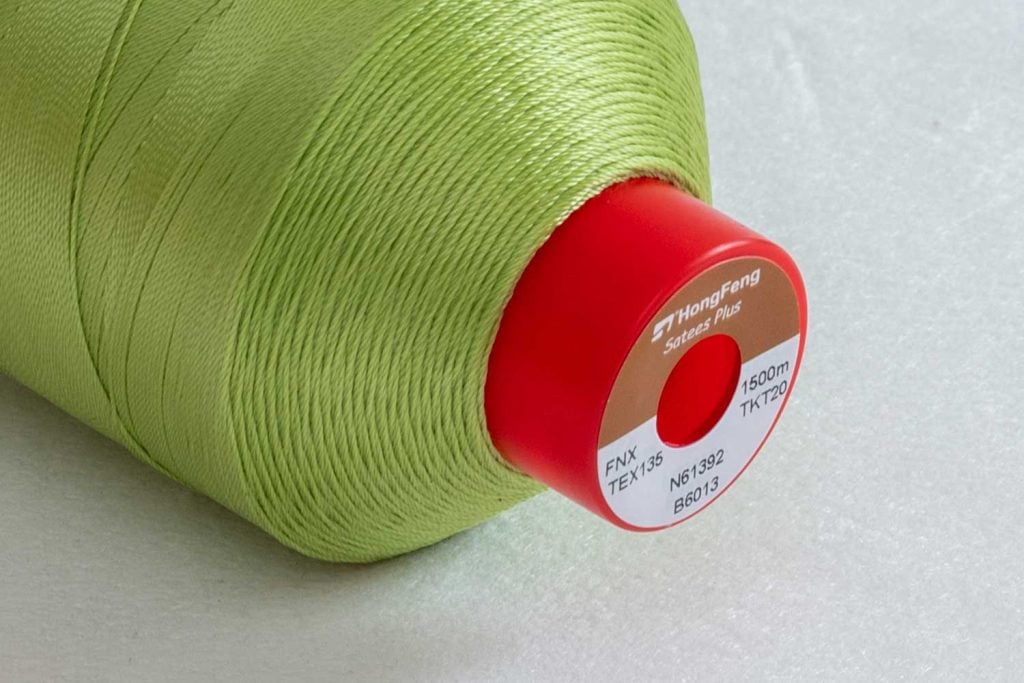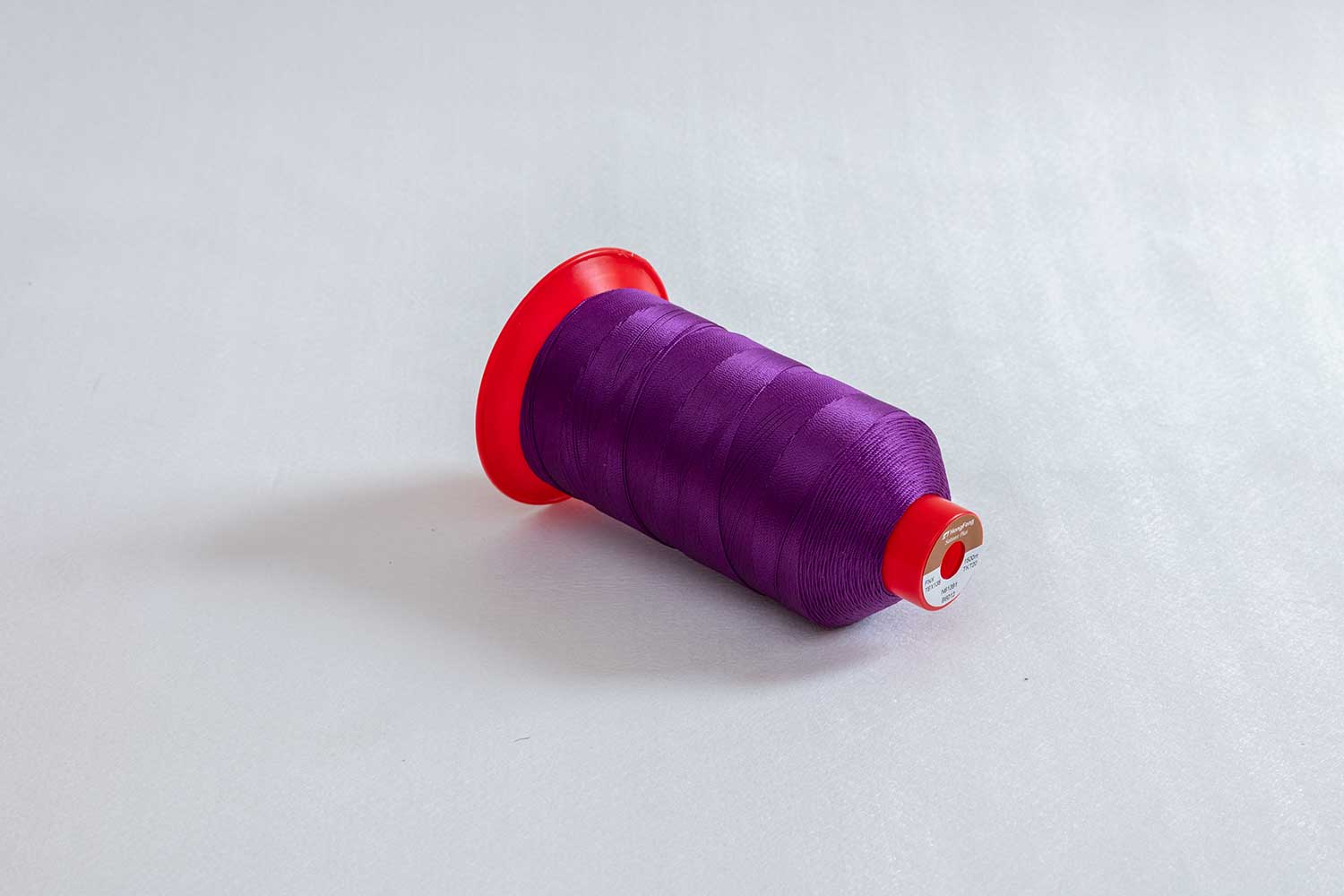Satees® plus
Bonded Nylon Thread
Bonded Nylon Sewing Thread
Hongfeng Satees® Plus is a bonded nylon thread. Hongfeng Satees® has the advantage of high tenacity and superior abrasion resistance and can improve the productivity and performance of the sewing production line due to the unique bond technology.
Satees® Plus Bonded Nylon Thread Manufactured from nylon 6.6, it has high tensile strength, is chemically stable, and rot-proofed.
Satess®Plus Bonded Nylon Thread Size Parameters
| TEX | METRIC | LENGTH | RA (dTex) | BSA (cN) | EBA (%) | DHS 150℃(%) |
| 35 | Tkt 080 | 2,000M | 395 | 2170 | 24 | <3.0 |
| 45 | Tkt 060 | 2,250M | 585 | 3290 | 24 | <3.0 |
| 70 | Tkt 040 | 1,500M | 851 | 4750 | 25 | <3.0 |
| 90 | Tkt 030 | 1,500M | 1126 | 6200 | 25 | <3.0 |
| 135 | Tkt 020 | 1,500M | 1710 | 9630 | 27 | <3.0 |
| 210 | Tkt 013 | 900M | 2390 | 14700 | 30 | <3.0 |
| 270 | Tkt 010 | 750M | 3275 | 18220 | 30 | <3.0 |
| 400 | Tkt 008 | 600M | 4085 | 20690 | 30 | <3.0 |
Standard for color fastness of bonded nylon thread
| International standard | Name | Degree of staining |
| ISO 105 C10 | Wash Fastness | Grade 4 |
| ISO 105 X12 | Rub Fastness | Grade 4 |
Colorfastness test of Satess® bonded nylon sewing thread
| International standard | Soap solution | Temperature | Time | Degree of staining |
| ISO 105 C10 | 5g/L | 60℃+/-2℃ | 30Min | Grade 4 |
Further reading

What is Bonded Nylon Thread?
Nylon filament thread product is a kind of industrial filament sewing thread with elasticity and high elongation. It is made of continuous filament nylon fibers twisted together. It is smooth and soft. Burning white smoke. High wear resistance, good optical rotation resistance, mildew resistance, coloring degree of about 100 degrees, low-temperature dyeing. It is widely used because of its high seam strength, durability, and flat seam, and can meet the needs of a wide range of different sewing industrial products.
Bonded Nylon Thread – Bonded Nylon Sewing Thread has a protective coating bonded to the nylon filament thread that protects against fraying, needle friction, and heat when sewing at high speeds. Bonding also helps prevent unraveling.
Bonded Nylon Thread manufactured from nylon 6.6 or 6, it has high tensile strength, is chemically stable, and rot-proofed.
TIP: The bonded sewing thread on the spool is normally slightly darker in color.
Chemical resistance of bonded nylon sewing thread
- Bleaching Agents and Solvents: Nylon filament yarn can be bleached in most solutions, but is generally insoluble in most organic solvents. It is soluble in certain phenolic compounds.
- Hydrocarbons: Nylon threads have excellent resistance to hydrocarbons such as gasoline, diesel, and kerosene.
- Acids and Bases: Nylon threads are immune to most inorganic acids, with the exception of hot inorganic acids. It dissolves and partially decomposes in concentrated solutions of hydrochloric acid, sulfuric acid, and nitric acid. Soluble in formic acid. Basically inert in alkali.


Features of bonded nylon thread?
Bonded Nylon Thread’s high strength-to-size ratio, abrasion resistance, sewing ease, and lower overall cost all attribute to its continued success in the industry. Bonded Nylon sewing thread can be used with most bleaches, organic solvents, most alkalis and mineral acids.
Bonded Nylon Thread stands up to heat, but is not fire retardant. It yellows at 300˚F and melts at 500˚F. Nylon has excellent resistance to mildew, aging, but will deteriorate with prolonged exposure to sunlight (UV). When sewing outdoor items that will be exposed to the sun polyester thread is recommended.
- Elongation – Bonded nylon filament thread stretches about 26% over time.
- Anti-mildew, anti-aging, and sun-resistant – Nylon filament yarn has excellent anti-mildew and anti-aging properties, but prolonged exposure to sunlight can cause some deterioration. Polyester filament sewing thread or specially treated UVR nylon is better for prolonged exposure to sunlight. Nylon is usually fine if the seams are not exposed.
- Abrasion Resistant – Bonded nylon sewing thread has excellent abrasion resistance.
- Heat – The bonded nylon sewing thread will start to yellow around 300F. Prolonged exposure to temperatures above 285F will cause deterioration. Nylon filament thread starts to stick around 445F and melts around 485 to 500F.
Needle And Thread Chart For Sewing Machines
The following chart compares various bonded nylon or polyester sewing thread specifications and the minimum needle sizes required
The V size is the common US measurement for twisted, multi-ply bonded nylon thread or polyester threads. Larger numbers indicate heavier threads.
The T sizes represent the “Tex” measurement system, where the number equals the weight in grams of 1000 meters of thread. If 1,000 meters weigh 70 grams, it is a Tex 70 thread. Larger numbers indicate heavier threads.
Please note that the “Tkt” (Ticket) sizes are equivalent to the Metric “M” thread sizes used in some countries. Smaller numbers indicate heavier threads.
| Minimum NeedleUS/Metric | Thread Size: V (T) [Ticket] | Government Size | Yds/Pound | Break Strength | Diameter |
|---|---|---|---|---|---|
| 12/80 | 33 (T30) [Tkt 80] | AA | 13,800 | 1.8 lbs | .0050″ (.127mm) |
| 14/90 | 46 (T45) [Tkt 60] | B | 9,600 | 7.5 lbs | .0094″ (.238mm) |
| 16/100/ or 18/110 | 69 (T70) [Tkt 40] | E | 6,000 | 11 lbs | .0115″ (.292mm) |
| 19/120 | 92 (T90) [Tkt 30] | F | 4,200 | 14.5 lbs | .0133″ (.337mm) |
| 22/140 | 138 (T135) [Tkt 20] | FF | 3,000 | 22 lbs | .0163″ (.414mm) |
| 23/160 | 207 (T210) [Tkt 15] | 3 Cord | 2,000 | 32 lbs | .0200″ (.508mm) |
| 25/200 | 277 (T270) [Tkt 10] | 4 Cord | 1,500 | 45 lbs | .0231″ (.586mm) |
| 26/220 | 346 (T350) [Tkt 8] | 5 Cord | 1,200 | 53 lbs | .0258″ (.655mm) |
| 27/250 | 415 (T400) [Tkt 7] | 6 Cord | 1,050 | 72 lbs | .0283″ (.718mm) |
| 30/330 | 554 (T600) [Tkt 5] | 8 Cord | 655 | 83 lbs | .0326″ (.828mm) |
Bonded Nylon Sewing Thread Restrictions
Bonded nylon thread is popular for its versatility, durability, and dimensional strength.
Outdoor applications with prolonged exposure to sunlight. High-strength filament nylon sewing thread can withstand moderate sun exposure, provided it is not exposed to the sun for extended periods of time or has some kind of ultraviolet (UV) protection (such as windshields or unexposed seams). That’s why it is popular in automotive interiors, upholstery, and many other applications. It should not be used on outdoor furniture and sewing sails, awnings, or tarpaulins. In these cases, polyester high-strength thread or UVR nylon thread is a better choice. Polyester looks and feels similar to nylon and has a very similar size strength.
Flame Retardant Apparel and Gear – Nylon High Strength Sewing Thread will yellow at 300F, stick at 445F and melt at 500F. First responder clothing and equipment and some high-temperature conveyor belts require higher flame resistance. Use aramid or flame-retardant sewing thread in these cases. They are heat resistant to 600F or higher and will not melt. However, they do not treat UV light as well. Their price is much higher than nylon.
Critical Strength Requirements
Nylon is strong, but Kevlar (aramid) is about twice as strong. For example, 92-gauge nylon has a tensile strength of 15 pounds; Kevlar (aramid) in the same size has a tensile strength of 30 pounds. The downside to Kevlar (aramid) is that it costs about five times as much as nylon and is only yellow. Consider using heavier-weight nylon or double stitching for strength requirements.
COTTON APPEARANCE
Our bonded nylon sewing thread has a smooth, shiny, shiny finish and is not suitable for garments that require a soft, fuzzy, cotton look. In these cases, cotton, spun polyester, and wool nylon are better and less expensive options.
Transparent or invisible suture Related categories: Monofilament thread. Monofilament is also made of nylon. It is constructed similarly to a fishing line and is classified separately.
Chemical Resistance
Nylon handles some chemicals well but not others.



